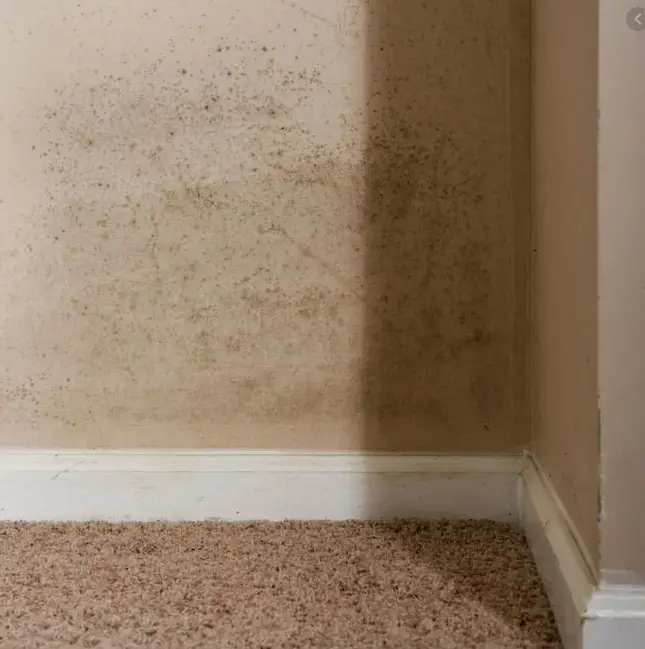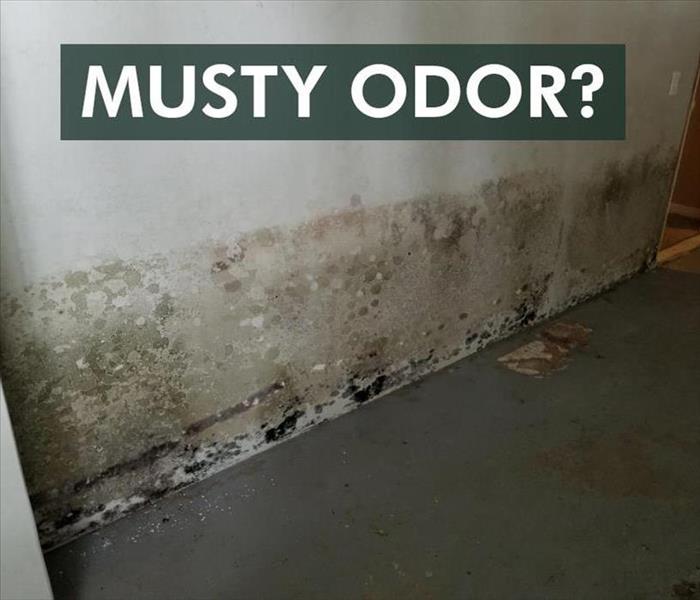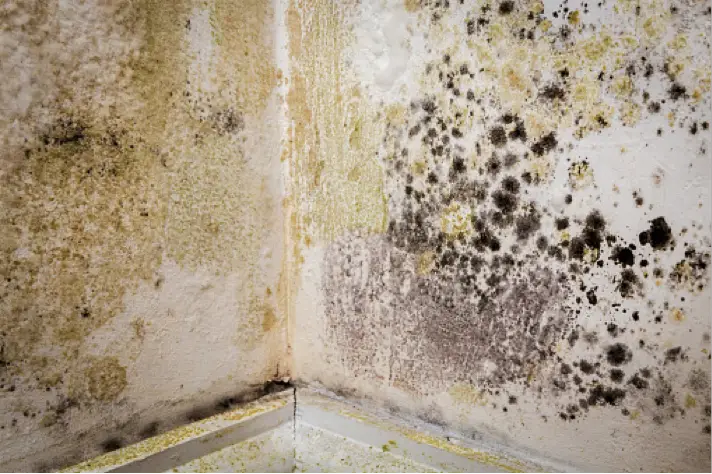Mold Behind The Walls
One common issue people with water damage have to deal with is mold behind their walls. In some cases, mold can be easy to visually identify and take care of, but in many cases, its the mold you cant see that is the biggest problem.
So if you cant see it, how do you know that you have a mold problem? If you start experiencing allergy symptoms such as those listed above, it may be a sign that there is some mold growing out of sight in your home, especially if there has been recent flooding or heavy rain. In addition, mold, even behind the walls, still leaves a trademark odor. If you start to notice a strange smell, this may be another indication that you need to call an expert!
Since mold is usually caused by water damage, it can be helpful to understand the different classes of water damage that can occur in the home. This will help to identify how serious the problem is and how it can be fixed.
Remove Mold From Cinder Block Walls
If it is growing on the surface of painted cider block in the basement or cinder block in the crawlspace, simply clean it using a good bathroom cleaner. Once the cinder block has been thoroughly cleaned, repaint cinder block using a paint that has an antimicrobial additive added to the paint. Since cinder block is often used in basements, so it the most important thing to do is to stop the moisture from seeping through the cinder block by using a waterproofing system on the walls.
Recommended Reading: How To Get Rid Of Powder Mold
Never Leave Water Damage Unchecked
Did you know that mold usually starts to grow within 24 or 48 hours when water is present? Many homeowners neglect to treat existing water damage because the issue looks relatively small or insignificant. However, even the smallest leak can lead to some big problems. It is crucial to deal with water damage early to ensure that the leak doesnt spread. Water damage that is not treated right away can end up causing severe structural damage that requires extensive repair. It is also one of the most common causes of mold in the home because the moisture creates a perfect environment for mold to grow. Some types of mold, particularly black mold, can become health hazards if they are left unchecked. Some people tend to have allergic reactions to even non-toxic mold. These tend to manifest with the following symptoms:
- Itchy, red, and/or watery eyes
- Excessive sneezing
- Cough and postnasal drip
Dealing with water damage early can prevent mold growth, which can in turn prevent these health problems.
Also Check: What To Do When There Is Mold In Your House
Don’t Miss: How To Make Mold Go Away
Can I Just Get Into The Wall And Use Bleach To Clean It
It may be tempting to get into the wall and spray everything with bleach by yourself. However, if you have never done this before, it is better to call someone licensed to deal with mold. This is especially true if you have never gone into the wall and dont know how to detect how extensive the mold damage is. Leaving the eradication of mold to professionals will save not only your health but also your sanity. A professional team will have all the protective gear, detection tools and methods necessary to get rid of all the mold in your home.
How To Remove Mold From Walls

Black mold has become a buzzword in house buying and selling, and it is undoubtedly a cause for concern if the mold in question is Stachybotrys, which has the highest toxicity. However, the fact is that all kinds of mold are everywhere, both inside and outside your house. The real problem is when mold levels are more concentrated inside than outside.
Often gray, white, green or black in appearance, mold in your house is most commonly found in damp, poorly ventilated, and warm places such as bathrooms, basements, kitchens, and laundry rooms. And whether or not it poses a high level of toxicity, you still donât want it on your walls. In this post, we will discuss how to remove mold from walls.
Recommended Reading: How Long Does It Take For Black Mold To Grow
Identify Areas Known To Harbor Mold
When you believe you smell mold, go on the hunt to find it. Look near water supply pipes, around water drainage lines and sewage pipes, anywhere near dryer vents and in laundry rooms, under sinks, in the ceiling above a finished basement, near bathroom exhaust vents, around sump pumps, and inside wall cavities.
Surface Changes And Deterioration
Your walls appearance can change significantly if theres mold growth behind them. In addition to discoloration and stains, your walls may deteriorate. Paint or wallpaper can crack, peel, or bubble because of moisture and mold growth. Furthermore, your walls may become warped or even bow or bulge when theres a water issue, which often leads to mold growth.
Recommended Reading: What Is The Symptoms Of Mold Poisoning
Mold Poisoning Symptoms In Humans
Mold poisoning can cause a number of different symptoms, depending on the age of the affected individual, the strength of their immune system, and whether or not they have a pre-existing mold allergy. Here are a few of the most common signs and symptoms of mold poisoning in humans.
- A stuffy or runny nose
- Sinus issues or infections
- Worsening or development of asthma
- Wheezing or difficulty breathing
- Skin itchiness, redness, or discomfort
- Fever and shortness of breath
What Am I Dealing With
So, how can you be sure youre dealing with a mold problem?
In some cases, there are visual signs of mold or clues that youre at risk for mold. For example, water stains on drywall arent a 100% indicator that you have mold, but theres obviously water getting there from some sort of source. With this in mind, chances are that youre going to get mold in time if you dont find and address the source. This is part of the reason many experts recommend doing home examinations during periods of the year when theres a lot of humidity or rain.
You May Like: How To Clean Mold Off Walls With Vinegar
What Happens If You Eat Food With Mold
The thought of eating something moldy likely makes you want to gag. Most of the time, this is the only symptom youd get after eating moldy food. If somethings not right with your immune system and you eat something moldy, you might experience symptoms like:
- If you are allergic to mold, those allergy symptoms may be triggered also
If you notice mold on your food that you dont want to throw away, consult the USDAs guide on handling moldy food.
Signs Of Mold In Your House
There are several subtle signs that indicate that your home may have harmful mold.
1. Strange smell from the air conditioner or heater
If you think your heater or air conditioner has an unusual smell, you might want to check it out.
A stand-alone air conditioner is one of the main places where mold starts to grow. These devices are dark, damp, and often exposed to warm temperatures when not in use. If you put your air conditioner in a warm place in winter, this also increases the risk of mold.
Regularly check the condition of the air conditioner and clean it every two years.
2. The seams between the bathroom tiles have become dark
When you take a shower, pay attention to the seams between the tiles. If they are dark, it is most likely mold. Luckily, this type of mold is not that dangerous.
However, if your bathroom has been leaking recently or flooding an adjoining room, you may be dealing with a more toxic type of fungus that will be harder to remove.
3. Wallpaper starts peeling off
While wallpaper may discolor or wear out over time, wallpaper peeling is not normal. If the wallpaper bubbles or cracks, this indicates the presence of moisture on the walls. And moisture is a precursor to mold.
Pay attention to walls and any areas that look damp or warped.
4. Your cold wont go away
Symptoms of a mold reaction may be subtle. It can be a common runny nose or bouts of sneezing. If you feel like your cold has dragged on, this could be a hidden sign of a mold problem.
Also Check: How Do You Treat Mold On Wood
What Does Mold Smell Like
Mold has a noticeable damp and stale smell, almost like wet paper. If you notice this musty smell coming from parts of your house, youre probably dealing with a mold problem. Ceiling tiles, wallcoverings, and wood products are most susceptible to moisture, hence why they are often the target of mold. Follow your nose and locate the source.
If your house has a chimney thats been neglected for a while, chances are its full of mold. You can inspect it by smelling it, but we highly suggest hiring a professional for a quick checkup and routine maintenance.
Trust The Experts Trust Proclean

Our highly-trained, certifiedmold removalprofessionals follow a proven, step-by-step process to make your home or business safe again.
First, we visually inspect the area to find any potential mold, tracing it to the source if possible. Then, our team contains the affected area and removes moldy, non-salvageable, porous material and implements negative air pressure technology to keep harmful mold spores from traveling from the air to your lungs.
Next, we utilize advanced HEPA filtered vacuums to help eliminate mold on non-porous surfaces, then set up air scrubbers with HEPA filters.
Finally, we ULV fog with a powerful antimicrobial solution to ensure that we treat the deepest, darkest corners of your home then, we clean and sanitize the remaining salvageable contents as necessary.
The moment you notice mold, you must act. Even a small amount of mold in the home can multiply quickly, and its entirely possible that there is more existing mold than what meets the eye.
today to ensure the safety of your home and health of your loved ones within it.
Recommended Reading: What Can Mold In Your House Cause
What Is Mold And What Causes Mold In Your Home
Mold is, by broad definition, a type of fungus that sprouts from microscopic spores floating in the air. When clusters of mold spores grow on surfaces, they start to reproduce and become visible to the human eye. If you have mold allergies, asthma, or another lung condition, even breathing in the microscopic pores can trigger an attack. If you dont, you may not even be aware that there is mold in your home until you see it or smell it .
All homes have the key ingredients needed for mold growth: the presence of mold spores, a surface for it to grow on, oxygen, warmth, and darkness. When you add moisture, whether from a water leak, stagnant water, or high levels of humidity, into the mix, thats where mold problems begin. Knowing where mold is commonly found in homes can help you prevent and treat it so you can keep your home and body healthy.
Why Does Mold Form In Homes
Mold forms in homes because, in many cases, a home is the ideal place for mold to grow particularly in basements and other areas which may be dark and moist, and have a similar temperature all-year-round, due to furnaces and water heaters.
Essentially, there are mold spores in the air at all times and once they find a place thats hospitable to them, theyll start reproducing, causing a visible mold problem.
Read Also: How To Fight Mold In Basement
How Fast Does Black Mold Spread
Mold begins to grow as soon as its spores land on a damp, fibre-rich material and it can spread around the house within 24 to 48 hours. It colonizes in one to twelve days and grows at one square inch per day. In less than a week, it can cover surface areas of several square feet.
Unfortunately in most cases, mold is widespread and already a big problem before a problem is even suspected by the homeowners.
So What Is A Mycotoxin
Mycotoxins, literally fungus poison in Latin, are secondary metabolites that can be produced by molds, and are not living organisms. Mycotoxins are a byproduct of mold. Not all mold spores produce mycotoxins, but some do. So the molds that produce mycotoxins are the ones that could be categorized as toxic or poisonous.
So, where is the line between an allergic mold and a toxic mold? That line is defined by the presence of mycotoxins, and is NOT defined by color. Mycotoxins are invisible and cannot be detected just by looking at the mold growth.
What Do Mycotoxins Do?
These chemical substances can cause many health problems ranging from mild to severe. Even if you are not allergic to mold, you can be affected by mycotoxins.
Mycotoxins can be absorbed by the body in a number of ways including: through the skin, the airways , and through the intestinal lining . Detrimental health effects caused by mycotoxins can range from acute poisoning to long-term effects such as immune deficiency and cancer.2 Chronic disease sufferers, such as people with immunosuppressive disorders or underlying lung disease may be more sensitive to molds and mycotoxins in their environment.4
Mycotoxins are NOT something you want in your home! Keep reading to learn how you can remove them. To learn more about mycotoxins in foods check out the World Health Organizations article: Mycotoxins.
Recommended Reading: How To Clean Mold From Leather
Other Places In The Kitchen
Wooden cutting boards, trash cans, behind the stove and windows and window sills in the kitchen are like heaven for mold spores. They feed off of these places, so keeping them clean and dry is critical for keeping mold at bay.
To keep your kitchen mold free, be sure to:
- Ventilate when cooking and doing dishes by opening a window, using a fan, or both
- Wash the dishes every day, so they dont pile up in the sink
- Clean and dry the stove top, microwave, counters, cabinets, and window sills regularly
- Clean out the inside of your fridge and your fridge drip tray often
- Take the trash out every day
What Causes Mold In Walls
Water. Water causes mold in walls. Lets look at the most common ways it gets there.
- Building materials were either already moldy OR were installed wet.
- The house itself from not properly seated on the foundation which allowed rainwater, groundwater, and runoff to seep into the framing.
- Windows and doors are not properly installed and sealed. Water is able to penetrate into the wall cavity.
- Water intrusion from outside coming into your wall from rain or irrigation due to stucco, siding, etc on an exterior wall thats compromised.
- A roof leak that runs into your home and behind a wall.
- Pipes and plumbing connections fail and leak. Usually you will discover a burst pipe rather quickly. It is the slow water leaks that are the main culprit when plumbing failures cause mold in walls.
- Wastewater line / sewer drain line has a slow leak.
- Air conditioning condensation line breaks inside the wall.
- Toilet overflows, bathtub overflows, washing machine overflows, hot water heater breaks, or any other accumulation of a large amount of water in your home that ISNT dried out promptly and completely.
Don’t Miss: How To Clean Mold Off Natural Stone Shower
Five Most Common Causes Of Growth
Can Black Mold Spores Travel In The Air

Yes. Mold spores are airborne and can attach themselves to peoples skin, clothing, shoes, shopping bags, furniture, carpets, and even pets. Once spores enter your home, they can settle onto any surface and start to multiply. They can also enter your house through open doorways, open windows, and HVAC systems.
Mold spores are microscopic and are virtually found everywhere. They are naturally found in the air we breathe, both indoors and outdoors. Since spores are tiny and lightweight, they become airborne easily, every time we vacuum or walk on the carpets or even sit on our couch.
Don’t Miss: How To Prevent Mold In Storage Containers
Know When To Clean And When To Call
Its not hard to take care of mold as a homeowner, but its a good idea to know when to call in the pros. If you 1. smell a musty odor in your home you cant identify, 2. have health problems associated with mold, or 3. if an area of mold covers more than around 10 square feet, there is a good chance the mold problem is more than an isolated issue. When any of those three conditions are met, its time to call the professionals.
Especially if you dont live in our service area, check out our post: How to Choose the Best Black Mold Removal Company. We help you know all the questions to ask the company you interview, and give you all the correct answers.
The company you choose should know all the answers to the questions in our article. Dont get scammed! Get smart! Always ask a lot of questions before hiring anyone to work on your home.
Dont Miss: Is Mold Removal Covered By Insurance
